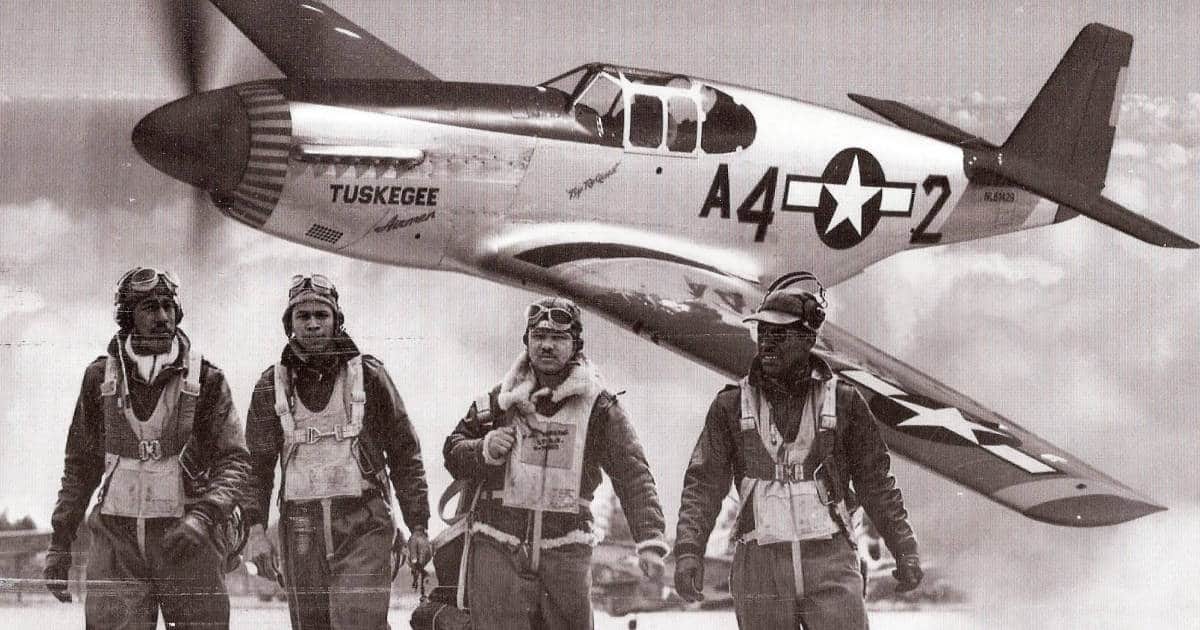African Americans played a significant role in America’s military history, despite the limited opportunities, adversity, and open hostility that they frequently had to contend with when trying to serve their country. Particularly from higher ups who believed that blacks were racially unsuited for leadership or combat duty, and so designed and implemented policies to deny them leadership opportunities and training. An example was the widespread conviction in American military aviation circles, before and during World War II, that blacks were manifestly unsuited for aerial combat.
Notwithstanding, African American pilots were trained and organized into racially segregated all-black squadrons that were sent to serve overseas, who came to be known as the Tuskegee Airmen, after their training base in Tuskegee, Alabama. They flew P-40 Warhawks, Bell P-39 Airacobras, Republic P-47 Thunderbolts, and finally, the planes with which they became most closely associated, P-51 Mustangs. They put up impressive numbers during the conflict, and by the time the war was over, they had put to rest the myth that aviation was too challenging for African Americans.

African Americans Had to Fight Tooth and Nail to Serve as Military Aviators
In World War I, African Americans tried to fly or serve as aerial observers in the US military, but were rejected. Their numbers included Eugene Bullard, a black pilot who flew for the French air force during the war, because his own country’s military aviation would not have him. Blacks continued to be barred from serving in US military aviation until pressure and successful lobbying by civil rights groups got Congress to pass a bill in 1939 to train black flyers.
The War Department and the military aviation establishment dragged their feet and slow walked the implementation of the legislation, until 1941, when they finally gave in to pressure and created the 99th Pursuit Squadron. In accordance with the military’s racial segregation policies, the 99th was an all black flying outfit. The unit had 47 officers and 429 men, and training began in Tuskegee, Alabama, in July of 1941, with the first class of five black fighter pilots graduating in March of 1942. They included Benjamin O. Davis, Jr., the first black officer to solo an Army Air Corps plane. He was promoted to lieutenant colonel that July, and placed in command of the 99th.
However, even as the Tuskegee training pipeline began pumping out black aviators, most were left to cool their heels, with no assignments, as plans to place them into command slots were slow walked or resisted by higher ups. The US Army Air Forces’ commanding general, Henry “Hap” Arnold, was among those who were lukewarm to placing black officers in operational slots. One of his stated objections was that: “Negro pilots cannot be used in our present Air Corps units since this would result in Negro officers serving over white enlisted men creating an impossible social situation“.

It took more public pressure from civil rights groups and the black press, plus the personal intercession of the president, before the military finally relented, and declared the 99th combat ready in April of 1943. It was shipped to North Africa, where it flew P-40 Warhawks as operational fighters. Its first combat assignment was to participate in Operation Corkscrew, the air assault on the Italian island of Pantelleria, to clear the way for the upcoming Allied invasion of Sicily.
Flying out of Tunis, the 99th carried out its first combat mission on June 2nd, and Operation Corkscrew turned out to be an auspicious start for the Tuskegee Airmen. Pantelleria, with a garrison of about 11,000 Italians and 100 Germans, surrendered on June 11th – the first time in history that a sizeable ground force surrendered because of aerial attacks. However, the 99th was unfairly criticized by some white aviators – including their own commander – who accused the unit of “failure to … display aggressiveness and daring for combat“, and called for its disbandment. The 99th was cleared by an Army Air Forces investigation, which revealed that the unit had performed just as well or better than other squadrons flying P-40s. Rather than get disbanded, the close look at the black flyers’ performance ended up earning their squadron a Distinguished Unit Citation.

